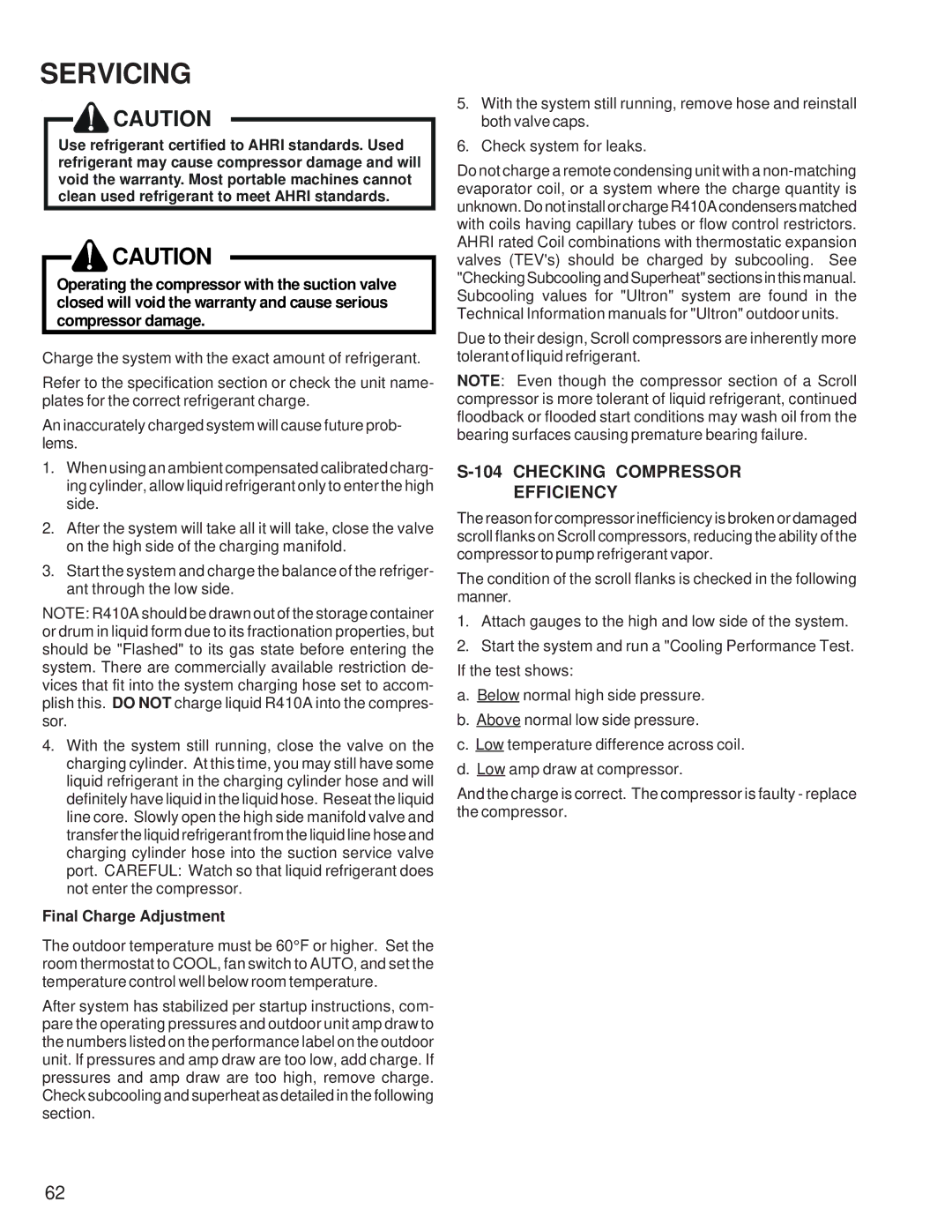
SERVICING
![]() CAUTION
CAUTION
Use refrigerant certified to AHRI standards. Used refrigerant may cause compressor damage and will void the warranty. Most portable machines cannot clean used refrigerant to meet AHRI standards.
![]() CAUTION
CAUTION
Operating the compressor with the suction valve closed will void the warranty and cause serious compressor damage.
Charge the system with the exact amount of refrigerant.
Refer to the specification section or check the unit name- plates for the correct refrigerant charge.
An inaccurately charged system will cause future prob- lems.
1.When using an ambient compensated calibrated charg- ing cylinder, allow liquid refrigerant only to enter the high side.
2.After the system will take all it will take, close the valve on the high side of the charging manifold.
3.Start the system and charge the balance of the refriger- ant through the low side.
NOTE: R410A should be drawn out of the storage container or drum in liquid form due to its fractionation properties, but should be "Flashed" to its gas state before entering the system. There are commercially available restriction de- vices that fit into the system charging hose set to accom- plish this. DO NOT charge liquid R410A into the compres- sor.
4.With the system still running, close the valve on the charging cylinder. At this time, you may still have some liquid refrigerant in the charging cylinder hose and will definitely have liquid in the liquid hose. Reseat the liquid line core. Slowly open the high side manifold valve and transfer the liquid refrigerant from the liquid line hose and charging cylinder hose into the suction service valve port. CAREFUL: Watch so that liquid refrigerant does not enter the compressor.
Final Charge Adjustment
The outdoor temperature must be 60°F or higher. Set the room thermostat to COOL, fan switch to AUTO, and set the temperature control well below room temperature.
After system has stabilized per startup instructions, com- pare the operating pressures and outdoor unit amp draw to the numbers listed on the performance label on the outdoor unit. If pressures and amp draw are too low, add charge. If pressures and amp draw are too high, remove charge. Check subcooling and superheat as detailed in the following section.
5.With the system still running, remove hose and reinstall both valve caps.
6.Check system for leaks.
Do not charge a remote condensing unit with a
Due to their design, Scroll compressors are inherently more tolerant of liquid refrigerant.
NOTE: Even though the compressor section of a Scroll compressor is more tolerant of liquid refrigerant, continued floodback or flooded start conditions may wash oil from the bearing surfaces causing premature bearing failure.
S-104 CHECKING COMPRESSOR
EFFICIENCY
The reason for compressor inefficiency is broken or damaged scroll flanks on Scroll compressors, reducing the ability of the compressor to pump refrigerant vapor.
The condition of the scroll flanks is checked in the following manner.
1.Attach gauges to the high and low side of the system.
2.Start the system and run a "Cooling Performance Test. If the test shows:
a. Below normal high side pressure. b. Above normal low side pressure.
c. Low temperature difference across coil. d. Low amp draw at compressor.
And the charge is correct. The compressor is faulty - replace the compressor.
62
